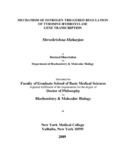Please use this identifier to cite or link to this item:
http://archive.nnl.gov.np:8080/handle/123456789/261| Title: | Mechanism of estrogen triggered regulation of Tyrosine Hydroxylase gene transcription |
| Authors: | Maharjan, Shreekrishna |
| Keywords: | TH gene expression Estrogen Tyrosine Hydroxylase gene transcription |
| Issue Date: | 15-Dec-2017 |
| Abstract: | Estrogens modulate the activity of the catecholaminergic systems through alterations in gene expression of catecholamine biosynthetic enzymes, including tyrosine hydroxylase (TH), which is the first and major rate-limiting enzyme in catecholamine biosynthesis (Nagatsu et al. 1964). However, reports on the response of TH in catecholaminergic systems to estradiol are confusing, revealing an increase, no effect, or a reduction. The basis for these discrepancies is unclear and may result from differences in dose, duration, mode of administration, or estrogen receptor (ER) subtype expressed. We found that administration of estradiol benzoate increased TH mRNA levels and modulated the response to stress in the adrenal medulla of OVX female rats. We also found that ER and ER were differentially expressed in these tissues under basal conditions and in response to stress. To study the molecular mechanisms and effect of ER subtypes at the cellular level, we cotransfected PC12 cells with expression vectors for ER or ERβ and TH reporter constructs. E2 elevated TH promoter driven reporter activity with ER, while it triggered a reduction with ER. Mapping the proximal promoter elements showed that a region at -45 containing the cAMP/Calcium response element (CRE/CaRE) was required for the response. MatInspector software analysis of this region revealed a novel almost perfect canonical estrogen response element (ERE) overlapping CRE/CaRE. Electromobility shift assay (EMSA) with oligonucleotides spanning the region displayed weak binding to ER and strong binding to CRE/CaRE binding protein (CREB). Moreover, E2 modulated the cAMP increase in TH gene transcription with both ERs. Further studies found that in the presence of ER, the membrane impermeable E2BSA triggered a similar elevation of TH promoter activity and require CREB and its phosphorylation at Ser133 through rapid activation of PKA and MEK signaling pathways elicited by E2 or E2BSA. The findings reveal several ways whereby estrogen can regulate TH transcription. The study demonstrates transcriptional regulation of TH by estrogen depending on the ER subtypes. The requirements of ER and CREB at the overlapping ERE and CRE/CaRE indicate integration of interactions elicited by various regulators of TH transcription including cAMP and estrogens. The findings also reveal regulation of TH gene transcription by membrane initiated rapid estrogen signaling. These data demonstrate potential mechanisms of estrogen effects on catecholaminergic systems in vivo. |
| Description: | A Doctoral Dissertation in Department of Biochemistry & Molecular Biology Submitted to Faculty of Graduate School of Basic Medical Sciences in partial fulfillment of the requirements for the degree of Doctor of Philosophy in Biochemistry & Molecular Biology at New York Medical College, Valhalla, New York, 2009. |
| URI: | http://103.69.125.248:8080/xmlui/handle/123456789/261 |
| Appears in Collections: | 500 Natural sciences and mathematics |
Files in This Item:
| File | Description | Size | Format | |
|---|---|---|---|---|
| Shreekrishna Maharjan PhD Thesis 2009.pdf | 6.46 MB | Adobe PDF |  View/Open |
Items in DSpace are protected by copyright, with all rights reserved, unless otherwise indicated.